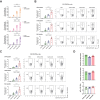Heterologous prime-boost vaccination drives stromal activation and adaptive immunity against SARS-CoV-2 variants
- PMID: 40503231
- PMCID: PMC12151836
- DOI: 10.3389/fimmu.2025.1597417
Heterologous prime-boost vaccination drives stromal activation and adaptive immunity against SARS-CoV-2 variants
Abstract
Heterologous vaccination strategies have shown superior efficacy over homologous regimens in clinical studies, but the underlying immunological mechanisms remain incompletely understood. Using a mouse model, we investigated the immune responses induced by heterologous prime-boost vaccination with adenoviral and mRNA vaccines. Heterologous vaccination (adenoviral prime, mRNA boost) elicited higher neutralizing antibody titers and stronger CD8+ T cell responses against Delta and Omicron-BA.5 variants compared to homologous regimens. Single-cell transcriptomic analysis of injection-site tissues revealed that adenoviral priming induced minimal changes in cellular composition but established a pre-conditioned innate immune environment. This effect was further amplified upon mRNA boosting, particularly through fibroblast-driven chemokine responses that promoted immune cell recruitment. These findings suggest that adenoviral priming enhances local immune activation upon boosting, contributing to the heightened adaptive immune response observed in heterologous vaccination. This study provides mechanistic insights into the immunological effects of heterologous prime-boost strategies against SARS-CoV-2 variants.
Keywords: COVID-19; adenoviral vaccine; cross immunity; heterologous vaccination; immune response; mRNA vaccine; single cell transcriptional analysis.
Copyright © 2025 Jeon, Kim, Kim, Shin, Park, Chang, Kang, Kim, Park, Youk, Kim and Yeo.
Conflict of interest statement
Authors K-SS, BP, SC, and C-YK were employed by the company Cellid Co., Ltd. The remaining authors declare that the research was conducted in the absence of any commercial or financial relationships that could be construed as a potential conflict of interest.
Figures






Similar articles
-
Ipsilateral or contralateral boosting of mice with mRNA vaccines confers equivalent immunity and protection against a SARS-CoV-2 Omicron strain.J Virol. 2024 Sep 17;98(9):e0057424. doi: 10.1128/jvi.00574-24. Epub 2024 Aug 28. J Virol. 2024. PMID: 39194250 Free PMC article.
-
Enhanced mucosal SARS-CoV-2 immunity after heterologous intramuscular mRNA prime/intranasal protein boost vaccination with a combination adjuvant.Mol Ther. 2024 Dec 4;32(12):4448-4466. doi: 10.1016/j.ymthe.2024.10.016. Epub 2024 Oct 28. Mol Ther. 2024. PMID: 39489918 Free PMC article.
-
Prolonged effects of adenoviral vector priming on T-cell cytokine production in heterologous adenoviral vector/mRNA COVID-19 vaccination regimens.Sci Rep. 2025 May 28;15(1):18684. doi: 10.1038/s41598-025-00054-x. Sci Rep. 2025. PMID: 40436912 Free PMC article.
-
A Meta-Analysis on the Immunogenicity of Homologous versus Heterologous Immunization Regimens against SARS-CoV-2 Beta, Delta, and Omicron BA.1 VoCs in Healthy Adults.J Microbiol Biotechnol. 2025 Feb 24;35:e2411059. doi: 10.4014/jmb.2411.11059. J Microbiol Biotechnol. 2025. PMID: 40147926 Free PMC article.
-
T and B cell responses in different immunization scenarios for COVID-19: a narrative review.Front Immunol. 2025 Mar 18;16:1535014. doi: 10.3389/fimmu.2025.1535014. eCollection 2025. Front Immunol. 2025. PMID: 40170841 Free PMC article. Review.
References
-
- Costa Clemens SA, Weckx L, Clemens R, Almeida Mendes AV, Ramos Souza A, Silveira MBV, et al. Heterologous versus homologous COVID-19 booster vaccination in previous recipients of two doses of CoronaVac COVID-19 vaccine in Brazil (RHH-001): a phase 4, non-inferiority, single blind, randomised study. Lancet. (2022) 399:521–9. doi: 10.1016/S0140-6736(22)00094-0 - DOI - PMC - PubMed
MeSH terms
Substances
Supplementary concepts
LinkOut - more resources
Full Text Sources
Medical
Research Materials
Miscellaneous

